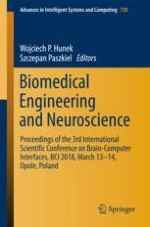This edition of the volume ‘Advances in Intelligent Systems and Computing’ presents the proceedings of the 3rd International Scientific Conference BCI. The event was held at Opole University of Technology in Poland on 13 and 14 March 2018. Since 2014 the conference has taken place every two years at the University’s Faculty of Electrical Engineering, Automatic Control and Informatics. The conference focused on the issues relating to new trends in modern brain–computer interfaces (BCI) and control engineering, including neurobiology–neurosurgery, cognitive science–bioethics, biophysics–biochemistry, modeling–neuroinformatics, BCI technology, biomedical engineering, control and robotics, computer engineering and neurorehabilitation–biofeedback.In addition to paper presentations, the scientific program also included a number of practical demonstrations covering, for example, the on-line control of mobile robot and unmanned aerial vehicle using the BCI technology.
